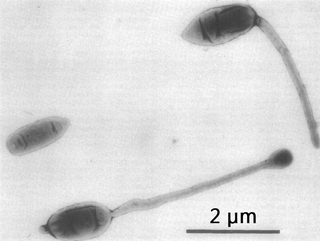
Arthrobacter is a genus of bacteria that is commonly found in soil. All species in this genus are Gram-positive obligate aerobes that are rods during exponential growth and cocci in their stationary phase. Arthrobacter have a distinctive method of cell division called "snapping division" or reversion in which the outer bacterial cell wall ruptures at a joint.
Rubrobacter is a genus of Actinomycetota. It is radiotolerant and may rival Deinococcus radiodurans in this regard.
Thermoanaerobacter is a genus in the phylum Bacillota (Bacteria). Members of this genus are thermophilic and anaerobic, several of them were previously described as Clostridium species and members of the now obsolete genera Acetogenium and Thermobacteroides
Dimethylsulfone reductase (EC 1.8.1.17) is an enzyme. This enzyme catalyses the following chemical reaction
Dimethyl-sulfide monooxygenase (EC 1.14.13.131, dimethylsulfide monooxygenase) is an enzyme with systematic name dimethyl sulfide,NADH:oxygen oxidoreductase. This enzyme catalyses the following chemical reaction
Paeniglutamicibacter cryotolerans is a species of bacteria. It is psychrotolerant, halotolerant, Gram-positive, motile, and facultatively anaerobic. It possesses a rod–coccus cycle.
Pseudoglutamicibacter cumminsii is a species of Gram-positive bacteria.

Hyphomicrobium is a genus of Gram-negative, non-spore-forming, rod-shaped bacteria from the family of Hyphomicrobiaceae. It has a large polar or sub-polar filiform prostheca very similar to that of Caulobacter. In addition to having a nutritional function, the prostheca also plays a role in the initiation of DNA replication.
Hyphomicrobium chloromethanicum is an aerobic, methylotrophic bacteria from the genus of Hyphomicrobium which can utilize chloromethane as the only source of carbon.
Hyphomicrobium denitrificans is a bacterium from the genus of Hyphomicrobium which was isolated from the Netherlands.
Hyphomicrobium nitrativorans is a bacterium from the genus of Hyphomicrobium which was isolated from biofilm at the Montreal Biodome in Canada.
Xanthobacter tagetidis is a bacterium from the family of Xanthobacteraceae which has been isolated from soil from Root balls around the plant Tagetes patula in the United Kingdom. Xanthobacter tagetidis has the ability to grow on substituted thiophenes.
Arthrobacter alpinus is a psychrotrophic, Gram-positive and aerobic bacterium species from the genus Arthrobacter which has been isolated from alpine soil from the Grossglockner area from the mountain range Hohe Tauern, in Austria.
Paenarthrobacter aurescens is a bacterium species from the genus Paenarthrobacter . Paenarthrobacter aurescens produces nitrilase and L-N-carbamoylase. Paenarthrobacter aurescens has a low GC-content and has the ability to utilize anethole.
Arthrobacter methylotrophus is a bacterium species from the genus Arthrobacter which has been isolated from soil around the roots of the plant Tagetes minuta.

Paenarthrobacter nicotinovorans is a Gram-positive and aerobic bacterium species from the genus Paenarthrobacter. This bacterium has the ability to degrade atrazine, nicotine, and creatine. and produces nicotine dehydrogenase
Methylorubrum thiocyanatum is a facultative methylotroph bacteria from the genus Methylorubrum that has been isolated from soil around the plant Allium aflatunense in Warwickshire, United Kingdom.
Paeniglutamicibacter gangotriensis is a bacterium from the genus Paeniglutamicibacter which has been isolated from soil from the station Dakshin Gangotri in Antarctica.
Glutamicibacter ardleyensis is a psychrotrophic and rod-coccus bacterium from the genus Glutamicibacter.
Ann Patricia Wood is a retired British biochemist and bacteriologist who specialized in the ecology, taxonomy and physiology of sulfur-oxidizing chemolithoautotrophic bacteria and how methylotrophic bacteria play a role in the degradation of odour causing compounds in the human mouth, vagina and skin. The bacterial genus Annwoodia was named to honor her contributions to microbial research in 2017.


